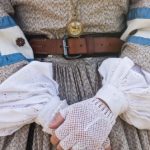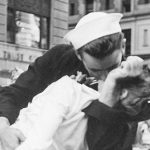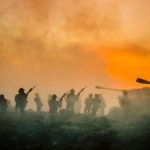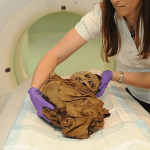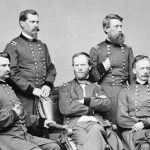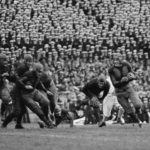 Technology
Technology  Technology
Technology  Humans
Humans 10 Everyday Human Behaviors That Are Actually Survival Instincts
 Animals
Animals 10 Animals That Humiliated and Harmed Historical Leaders
 History
History 10 Most Influential Protests in Modern History
 Creepy
Creepy 10 More Representations of Death from Myth, Legend, and Folktale
 Technology
Technology 10 Scientific Breakthroughs of 2025 That’ll Change Everything
 Our World
Our World 10 Ways Icelandic Culture Makes Other Countries Look Boring
 Misconceptions
Misconceptions 10 Common Misconceptions About the Victorian Era
 Mysteries
Mysteries 10 Strange Unexplained Mysteries of 2025
 Miscellaneous
Miscellaneous 10 of History’s Most Bell-Ringing Finishing Moves
 Technology
Technology Top 10 Everyday Tech Buzzwords That Hide a Darker Past
 Humans
Humans 10 Everyday Human Behaviors That Are Actually Survival Instincts
 Animals
Animals 10 Animals That Humiliated and Harmed Historical Leaders
Who's Behind Listverse?

Jamie Frater
Head Editor
Jamie founded Listverse due to an insatiable desire to share fascinating, obscure, and bizarre facts. He has been a guest speaker on numerous national radio and television stations and is a five time published author.
More About Us History
History 10 Most Influential Protests in Modern History
 Creepy
Creepy 10 More Representations of Death from Myth, Legend, and Folktale
 Technology
Technology 10 Scientific Breakthroughs of 2025 That’ll Change Everything
 Our World
Our World 10 Ways Icelandic Culture Makes Other Countries Look Boring
 Misconceptions
Misconceptions 10 Common Misconceptions About the Victorian Era
 Mysteries
Mysteries 10 Strange Unexplained Mysteries of 2025
 Miscellaneous
Miscellaneous 10 of History’s Most Bell-Ringing Finishing Moves
10 War Relics with Fascinating Stories
War has always been unavoidable. Evidence of warfare stretches from ancient times to at least 10,000 years ago. Anyone who wants to learn about history or humans has to know about the series of wars that shaped our civilization.
Most people generally avoid thinking, seeing, and reading about such things. But sometimes, we’re urged to do the opposite, possibly to gain perspective or to learn the rationale (or lack of it) behind world-shaping conflicts.
The following mementos of war, none of which are too gory, all illuminate some fascinating stories—and facets of humans’ innate need to be violent toward each other.
Related: Top 10 Stolen Artifacts Displayed In Museums
10 Food Rationing Cards Controlled Diets During WWI
The British were hard hit by food scarcity. Prices doubled, and things like meat, bread, and greens were often hard to find. Plus, public attitudes shifted as annoyances piled up. If people were at first happy to help, the accumulating stresses tested their patience and hunger. For example, food limitations grew stifling as ration cards could only be redeemed at certain stores.
And with the government controlling prices, some fare became rare, and long lines formed outside shops. Cheese, milk, sugar, tea, butter, and jam were to be eaten sparingly—a real blow to the British diet of sugared tea and jam-slathered crumpets. Some families could only afford one meal per day. Others ate meat only once per week.[1]
9 A Life-Saving Parachute Becomes a Wedding Dress
As B-29 pilot Major Claude Hensinger and crew were returning from a bombing mission over Yowata, Japan, in August 1944, their engine caught fire. Yet, thanks to his parachute, Hensinger suffered only minor injuries. He then used the parachute as makeshift bedding while awaiting rescue.
In 1947, when he proposed to his girlfriend Ruth, he offered the parachute as material for her wedding dress. Their daughter and their son’s bride would also go on to proudly don the dress.[2]
8 Gas Masks Were Made with Asbestos
It’s rare that you see anyone advocating for the destruction of wartime artifacts, but sometimes those war artifacts see evil. Okay, maybe not evil, but potentially harmful because they’re full of toxins.
In 2014, the Health and Safety Executive of the UK suggested destroying WWI artifacts that contain asbestos. This pertained to helmets, gas masks, and other artifacts displayed to the public or shared with children for educational purposes.
Of the 34 helmets checked, both German and British, 29 contained asbestos in their filters. Six of these contain the extra-dangerous “blue asbestos,” or crocidolite. Obviously, historians, as well as sensible people, were appalled by the suggestion of destroying irreplaceable pieces of history. Given that this was only ascertained in the 2000s, the health status of their contemporary wearers is uncertain.[3]
7 Trench Periscopes Kept Soldiers Safe(r)
Trench warfare was truly horrifying, and its many horrors inspired many innovations, offensive and defensive. This is a combination of both.
Trenches offered a modicum of safety, yet only when firmly entrenched—and if we discount the rats and trench foot. But any soldier peeking above the parapet was in danger of lethal injury. Accordingly, an Adams & Company periscope (dated 1917) allowed a less-risky view of no man’s land in places like Pays de la Loire, Saint-Nazaire, in France.
It was painted a drab olive color to blend in and had a sliding wood-and-metal shutter over the viewfinder. It folded in half for storage because even space was a premium in those dank, dirty, cramped trenches.[4]
6 Mid-Air Bullet Collision Shows off a Deadly New Weapon
The Minié ball, though not really ball-shaped, was a significant Civil War adoption that revolutionized firearm-based warfare. It was conical and had grooves around its base, making it more accurate and deadly at greater range. It took advantage of the concept known as rifling: spinning a bullet as it’s fired gives it much greater aerodynamic stability.
The Minié bullet, developed in the late 1840s by French army officer Claude-Étienne Minié, helped make the Civil War a much deadlier affair. However, the two specimens are famous for meeting themselves rather than an opposing soldier. They clashed for their now-eternal embrace on “Bloody Hill” on August 10, 1861, during the Battle of Wilson’s Creek.
The bullets, one a .69 caliber and the other a .58 caliber, precipitated from “a perfect hurricane of bullets,” as quoted by Sergeant George W. Hutt, who was part of the 1st Kansas Infantry.[5]
5 Early Flamethrowers Were a Psychological Weapon
The flamethrower, or flammenwerfer, was invented by Richard Fiedler, a German engineer, at the turn of the 20th century. It was first used during WWI by German shock troopers, who utilized it as a siege weapon circa 1915, finding success in unleashing it against French trenches near Verdun on the Western Front.
The flamethrower was then demoted from a frontal assault weapon to one used for clearing trenches or other fortified spots—its short range of about 20 yards and low fuel supply severely limited its effectiveness as a feasible attack option. However, it made up for its practical shortcomings with its psychological impact, as it has since become arguably the most terrifying wartime weapon most people can imagine.[6]
4 WWII C-Ration Displays Culinary Evolution
C-Rations were the evolution of the reserve rations that fed American troops during WWI. These 12-ounce cans were opened with a key and contained a few types of prepared food, including bacon, beef, biscuits, sugar, coffee, and salt. They sometimes also contained even more desirable fare to some soldiers: tobacco and rolling papers. The rations further evolved with more sophisticated options, such as stews, spaghetti, and candy.
One of the most intriguing facts? Some people collect these and similar antiques, and have tried tasting the contents of these old canned rations.[7]
3 “Bitten” Bullets Were a Myth (but Also Real)
Civil War medicine was obviously nowhere near as advanced as modern medicine, but it also wasn’t as backward or devoid of options as many people may believe.
For example, surgery patients did not bite bullets, as the myth goes. Yes, old-timey surgery was brutal and nowhere near as sanitary as surgery should be. Yet some therapeutic choices were available, such as chloroform and ether, to help relieve patients. Oddly enough, wartime artifacts do include a number of bullets that were indeed bitten. They weren’t bitten by wounded soldiers receiving bone-gnashing care or any humans—but by hogs foraging battlefields after combat had subsided.[8]
2 Fuse Pins Served as a Makeshift Diary
Technical Sergeant Garland Kerlec was a flight engineer aboard the B-17 bomber. Kerlec flew many missions, faced many risks, and was always ready to jump into the gunner’s turret to protect his crew. His bomber had been shot up, suffered engine failure, and faced other lethal situations.
In lieu of a formal diary, he recorded these trying events on the cotter pins and bomb fuse tags that kept the onboard explosives from detonating prematurely. Sometimes, top brass mandated that soldiers return all of these pins, but as always in war, some leaders are more lax than others—as long as the job gets done.[9]
1 Caption Leonard’s Helmet Commemorates the First American on Normandy
Leonard T. Schroeder Jr., U.S. Army Captain, was the first American on the beaches of Normandy from a landing craft. He was the first to descend the landing ramp and plunge into the waist-deep waters at Utah Beach on D-Day, leading the 32 men aboard his Higgins Boat into battle as air support still shelled the shore.
Despite landing 2,000 yards off target and sustaining a gunshot wound to his left arm, Schroeder undauntedly led his men as part of the successful assault to take the town of Sainte-Marie-du-Mont. He was again wounded in the same arm, but doctors were fortunately able to save his limb. Schroeder received the Silver Star, and his M-1 helmet and liner with an ivy cross now sits in a museum.[10]
+ BONUS: George Washington’s Camp Bed
When we think of generals, we often picture them issuing orders from tactical outposts far removed from the encampments of their troops. Yet George Washington was a man of his soldiers, who carried various tools (like eating utensils) to personally employ while encamped with his Revolutionary War troops. One of the most intriguing items is his not-too-comfortable camp bed, which he likely used circa July 1783 as he toured military installations in upstate New York toward the closing of the American Revolution.[11]

